Agronomy Update
Apr 28, 2025
Horizon Resources Patronage
2024 was a successful year for Horizon Resources and our growers were very happy with their patronage checks paid out at our annual meeting last week. Just to give you an idea of how Horizon Resources has performed since our first year in 2006, we have paid a total of $90,411,647 in cash payments along with $158,771,170 in stock payments for a total of $249,182,817 in total patronage to our customers. A quarter of a billion dollars!Just for the 2024 business year, Horizon Resources paid back over $21 million to our customers, with $10,762,407 in cash and $10,762,407 in stock. For Agronomy alone, we paid back 12.66% on all of your agronomy purchases.
12.66% equates to discounts on the following products of these amounts:
- $100 per ton on NH3
- $75 per ton on urea
- $100+ per ton on MicroEssentials S-10 starter fertilizer
- $95 to $100 per bag on Invigor Canola seed
- $30 to $40 per bag on Croplan RR corn
- $95 per gallon on Sharpen
- $2+ per gallon on RT-3
- $1+ per acre on custom application
For other business units, patronage was paid at these amounts
- $2.25 per 100/wt. on canola
- $0.45 per bushel on durum
- $0.43 per bushel on spring wheat
- 12.33% on retail petroleum ($.37 per gallon on $3 per gallon gas)
Horizon Resources is a Cooperative and this is how a cooperative is supposed to work. We pay back our profits to our customers and we retain the stock portion to operate on, make improvements and invest in assets. We have been retiring our patrons’ stock portion starting at age 70 with half paid when requested at 70 years of age and then the second half the following year. We are paid up to age 70, so we are current on our stock patronage payouts, and we are a very financially solid company that will continue to pay our customers.
Not only have we paid our Horizon Resources customers, but we have paid all of the equity owed to members of former cooperatives that have merged into Horizon Resources. This includes Wildrose Farmers Union Oil, along with the parent cooperatives of Farmers Union Oil Company of Williston, Northwest Grain Cooperative, and Prairie States Cooperative. Some of these Coops might not have been able to pay equity on their own before merging, but Horizon Resources has paid up every dollar of merged equity as it was due to be paid, and we intend to follow through as years go on. It pays to do business with a cooperative and we keep proving it every year.
John Salvevold, Agronomy Division Manager, CCA

To learn more check out Episode 16 of season 2 of the On the Horizon podcast with COO/Grain Division Manager Levi Hall, CEO Jeff Wagner and Energy Division Manager Jeff Watts. Listen to the episode on YouTube or wherever you get your podcasts.
Anthem Flex in Lentil and Spring Wheat
Early weed control in lentils is critical to prevent competition at key growth stages and growers now have an herbicide tool which provides a high degree of flexibility. Anthem® Flex (pyroxasulfone + carfentrazone-ethyl) herbicide provides effective control in lentil fields on key grasses and broadleaf weeds including green foxtail (Group 1 & 2 resistant biotypes), yellow foxtail, barnyardgrass, pigweeds and suppression of kochia and Russian thistle. The broad-spectrum residual weed control found in Anthem Flex herbicide provides growers the flexibility that it was named for. In contrast to other herbicides labeled for lentils, Anthem Flex herbicide does not require incorporation and can be applied to pulse crops in the fall or spring prior to crop emergence for long residual control.
Prashant Jha, Montana State University, 2018
Recommended application rates for lentils in North Dakota and Montana are 3.25 oz/A to 4.5 oz/A. If weeds are emerged at the time of application, then supplementing the Aim component of Anthem Flex can provide greater burn down activity. Add 0.57 oz/A Aim to 3.25 oz/A Anthem Flex or 0.4 oz/A to 4.5 oz/A Anthem Flex. This will give you the equivalent of 1.0 oz/A Aim. Don’t forget to add the MSO and AMS to this mix and apply a minimum of 10 GPA of water (the more the better). Coverage matters, and flat fan nozzles are going to do the best job in this scenario.
One important watch out with lentils is that you do NOT use saflufenacil (ex. Sharpen) containing products for your spring lentil ground if you applied Anthem Flex herbicide the prior fall or apply it together or sequentially in the spring. Possible injury may occur to the lentils from the interaction of the saflufenacil and the pyroxasulfone.
If you want to apply Anthem Flex to spring wheat in the spring, then it must be applied as a delayed PRE. This means that you apply Anthem Flex herbicide following planting when 80% of the wheat has germinated and grown at least a ½ inch shoot up until the spiking stage. In these situations, we typically run 2.75 – 3.25 oz/A. Overall, we like to see Anthem Flex applied in the fall for spring wheat when we can use the higher rates. The weed control you will receive from Anthem Flex will be much more consistent and stronger in Fall applications and this actually goes for all crops. In the no-till region of ND/MT our rainfall is sparse, and Anthem takes a good shot to get activated (especially where heavy residue/trash is on the soil surface).
REMINDER: DO NOT USE Anthem Flex on DURUM in any situation be they fall and/or spring applications
Ryan Hunt, Technical Services Manager, FMC

To learn more check out Episode 9 of season 2 of the On the Horizon podcast. Listen to the episode on YouTube or wherever you get your
Identifying Early Emerging Weeds
As we head out to perform burn down applications, take a look at the plant species which are already present in your fields. Some of our most problematic weeds emerge early in the year or have already emerged in the fall. There are also some plants out there that we really don’t need to be concerned with, as they are easily controlled and are already coming close to finishing their lifecycle by the time our crops start there’s.One example of a non-pest plant species is Fairy Candelabra (Androsace occidentalis). This is a small plant with a rosette of up to one inch in diameter. It is a fall or spring annual, and flowers from early to late spring. It will die shortly after flowering and so doesn’t compete with our crops, but even so is usually killed with our spring burndown.
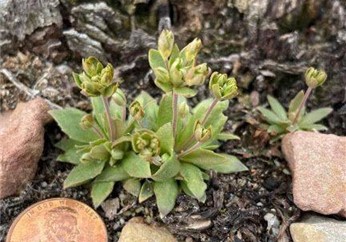
Fairy Candelabra, NDSU Extension
Yellow flowers can be cause for concern as we associate them with Narrowleaf Hawksbeard (NLHB) or weedy mustards, but yellow whitlow-grass (Draba nemorosa) is a native species within the mustard family that does not compete with our crops and is easily controlled. Another winter or spring annual, this plant doesn’t get much beyond 5 inches tall and flowers much earlier than the weeds of concern. The white flowered type can be confused with horseweed (marestail) but horseweed doesn’t flower until late summer, whereas the yellow whitlow-grass will have already completed its lifecycle at this point.

Yellow whitlow-grass
Related to forget-me-nots, waterpod (Ellisia nyctelea) is another common small, native annual that emerges in the early spring. It can grow anywhere from four to sixteen inches tall, and early in the season will be larger than the biennial wormwood or common ragweed that they might be mistaken for. The fully grown leaves will be around four inches long and have a minty smell when rubbed. Again, these plants are easily controlled with the burn down application.

Waterpod
The chart below was created by Kyle Okke (Agile Agronomy, LLC) to highlight the emergence patterns of many of our problematic weeds. As you can see, some of the first weeds to come up are wild oats and kochia, with Russian thistle, redroot pigweed, barnyard grass, foxtails, lambsquarters and wild buckwheat not far behind. Narrowleaf hawksbeard (NLHB) and marestail likely emerged in the fall, and hopefully we put a product down at that point. If we are controlling these weeds in the spring then we have to get them while they are still small. Our spring burn down is targeting these early emerging species, and hopefully we time our in-crop herbicide to clean up the rest. There will be weeds that emerge beyond that window like late emerging Russian thistle or stinkgrass that we miss with our standard weed control practices.

Wild oat (Avena fatua) can compete with our crops very early on, and so having a residual product like Anthem Flex which can provide some suppression of this weed prior to your in-crop application is of value. It takes very few wild oat plants to cause yield loss. You can identify wild oat by how the leaves twist in a counterclockwise fashion and the lack of auricles. If you dig up the seedling you can see the oat type seed still attached to the root system. Below is a picture of a lentil field taken May 14th. The lentils were around an inch tall at that point, whereas the wild oat was already 3-4 inches tall. The key weed free period in lentils is 3-5 node.

Kochia has been one of the worst weeds in North Dakota since 1978, so it’s not surprising that this weed is absolutely everywhere. The high level of genetic diversity combined with prolific reproduction has resulted in herbicide resistance to multiple groups including group 9 (glyphosate), group 2 (ALS—Harmony, Express, Raptor, Everest) and now group 14 (Valor, Sharpen, Spartan, Aim). Resistance to group 4 and group 5 herbicides has also been reported in North Dakota. Our options are really limited, so our best bet is to attack it with as many groups as we can, keep our water rates at 10 GPA or above and apply the highest rate with the proper adjuvant load. We need to kill it dead, not just injure it.
Kochia begins to emerge when soil temps hit 40°F and at least some has emerged at planting. It can continue to emerge through July, however, so hitting it in crop and using residual products when you can is equally important. Kochia has one of the highest seed to plant mass ratios, so we want to keep them from setting seed. This weed would be why using paraquat in a burn down setting might need to become a more common practice. To learn more about managing herbicide resistant Kochia listen to the Growing Pulse Crops podcast episode featuring Dr. Brian Jenks.
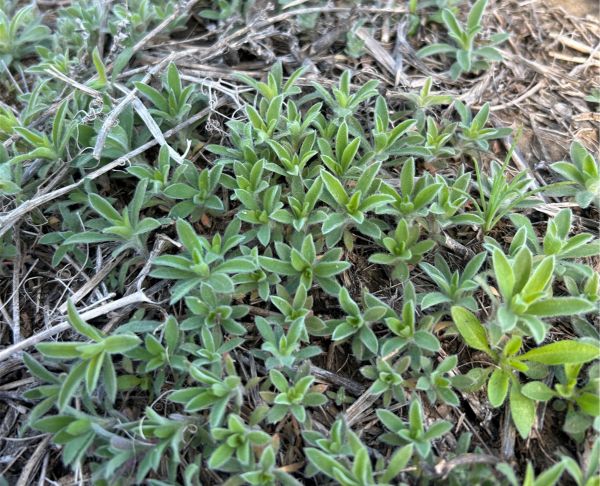
The picture below taken May 24th, shows a potpourri of the other later spring emerging weeds that we find including Russian thistle, foxtail, field bindweed and lanceleaf sage. Weed species will vary by field, and these weeds might each require a different management strategy for herbicide applications as we go from our post-harvest burndown, to fall residual, spring burndown and in-crop application. With the complications of herbicide resistance, weed management is now a year round game and crop rotation and planting dates will play a role in when we are managing these weeds.
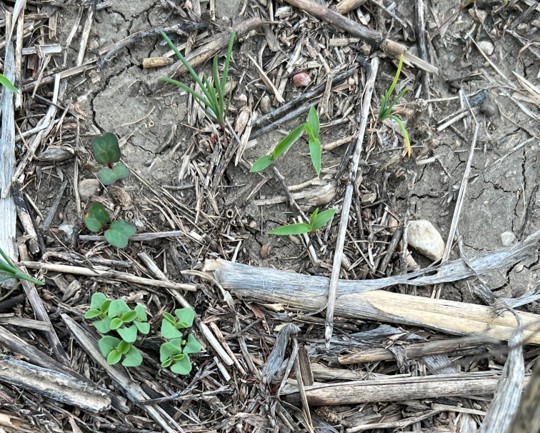

We have to be prepared for crop rotation interval limitations to actually get some of these weeds under control, especially when we are starting to discuss perennial weeds. Our winter annuals like narrowleaf hawksbeard (NLHB in image above from Kyle Okke) and horseweed that are resistant to glyphosate are controlled most easily in the fall when they are small. By the time we get to them in the spring they might be too big to control, even if we are spraying an effective herbicide

Narrowleaf hawksbeard rosette, NDSU Extension
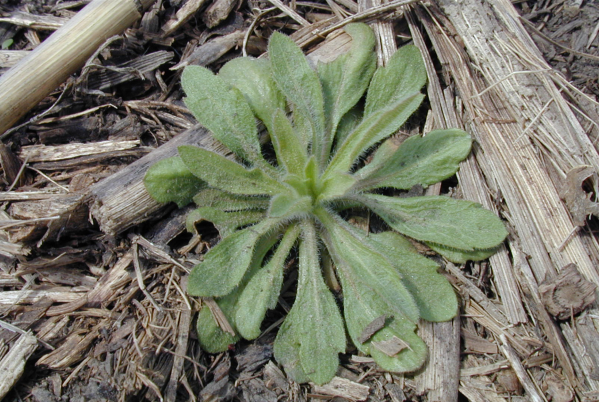
Horseweed (marestail) rosette, Iowa State University
Scouting fields and keeping records of which weeds are where will help target herbicides effectively and manage weed seed banks. Some weeds, like narrowleaf hawksbeard have short lived seeds, so if they are controlled effectively for a few seasons, we can be less worried about controlling it in future years. When we are out scouting, we attach scouting reports to fields in the FarmQA app which can be a reference in future years. If you have any questions about using the FarmQA app feel free to reach out.
Dr. Audrey Kalil, Agronomist & Outreach Coordinator
Environmental Conditions and Seeding Depth Impact Canola Emergence
Canola can emerge anywhere from four to fifteen days after planting and germinates at temperatures as low as 36°F. We have some canola fields in the area that are already starting to emerge.
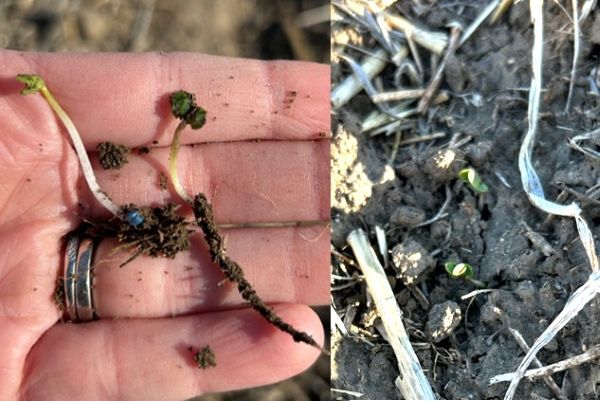
Canola emerging April 25th, 2025

Impact of soil temperature on canola germination, Manitoba Canola Growers. (2°C = 36°F, 8°C = 46°F)
Early-planted canola crops often achieve higher yields, as they are less likely to encounter heat stress during flowering. However, early planting comes with concerns about frost damage. Canola emerging in cold soils does so slowly, potentially exposing seedlings to several days of near-freezing temperatures. This slow emergence triggers physiological changes—known as "hardening"—that improve the plant's frost tolerance. Seedlings that undergo this process can withstand temperatures as low as 18°F, while non-hardened plants may be damaged or killed at 26°F (NDSU Canola Production Guide). While the risk of frost isn't eliminated, early-seeded canola does have some capacity to endure cold snaps.
Beyond temperature, seeding depth can also significantly affect both emergence rate and final stand. Research conducted in Alberta and Saskatchewan (2008–2011) found that, under adequate moisture, canola seeded at 1 cm (0.39 inches) had better emergence compared to 4 cm (1.6 inches). Under drought conditions, however, overall emergence declined regardless of depth, and seeding depth had less influence (see graph below). In all scenarios, the number of emerged plants was typically lower than the seeding rate in these studies.

Cold soils may also reduce overall emergence, which is why the Canola Council of Canada suggests slightly increasing seeding rates when planting early. As we monitor fields for flea beetles after emergence, it's also a good time to evaluate your stand establishment. Assessing percent emergence can help determine whether you're optimizing your seeding strategy.
The Canola Council of Canada offers helpful tools and tips for measuring canola stands. When evaluating your fields, be sure to sample multiple locations and calculate an average for a more accurate assessment.
Dr. Audrey Kalil, Agronomist & Outreach Coordinator
| Average Bare Soil Temp (°F) | |||||||
| Location | 4/21 | 4/22 | 4/23 | 4/24 | 4/25 | 4/26 | 4/27 |
| Alamo | 45 | 42 | 45 | 44 | 49 | 46 | 54 |
| Alexander | 47 | 45 | 51 | 53 | 56 | 51 | 59 |
| Arnegard | 49 | 48 | 50 | 52 | 54 | 50 | 55 |
| Epping | 44 | 43 | 46 | 45 | 47 | 44 | 51 |
| Grenora | 44 | 43 | 45 | 46 | 48 | 47 | 51 |
| Hofflund | 49 | 46 | 46 | 50 | 52 | 50 | 54 |
| Pioneer | 44 | 44 | 46 | 47 | 49 | 46 | 52 |
| Sidney, MT | 43 | 43 | 44 | 46 | 51 | 49 | 53 |
| Williston | 44 | 44 | 46 | 48 | 50 | 46 | 53 |
